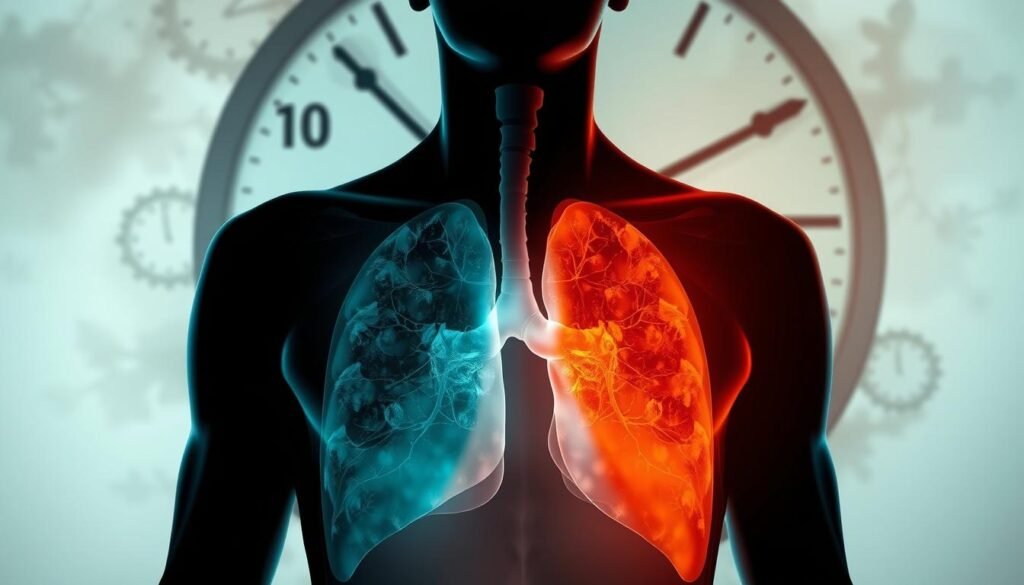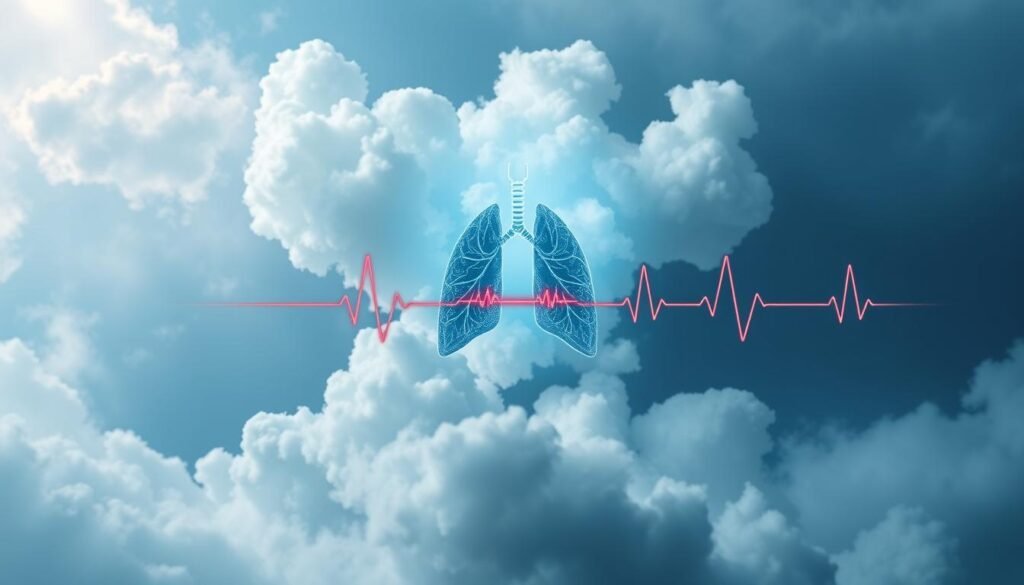Every year, around 1.5 million cases of pleural effusion are reported in the United States. This shows how common the issue of fluid buildup around the lungs is. It can deeply impact how long people live. Pleural effusion can be caused by many things, like infections and cancers. This makes it very important to understand for both doctors and patients.
This understanding helps in coming up with better ways to manage and treat it. Today, we’re going to look at how pleural effusion affects how long someone can live. We will explore the ways it influences survival rates.
Key Takeaways
- Pleural effusion affects approximately 1.5 million individuals in the US annually.
- The condition can significantly influence life expectancy and quality of life.
- Malignant pleural effusion has a mean survival rate ranging from 1.5 to 9 months.
- Mortality rates for pleural effusion patients escalate over time, reaching 32% at one year.
- Understanding the factors influencing pleural effusion can improve treatment outcomes.
- Bilateral pleural effusions lead to higher mortality rates than unilateral ones.
Understanding Pleural Effusion
Pleural effusion is when too much fluid collects in the pleural space around the lungs. This can make breathing hard and often points to other health issues. It’s vital to know the types of pleural effusion and their causes for proper diagnosis and treatment.
Definition and Types of Pleural Effusion
Pleural effusion means there’s a lot of fluid build-up. There are two kinds: transudate and exudate. Transudate effusions come from whole-body issues like heart failure and have less protein. Exudate effusions, however, come from local problems like cancers or infections, leading to more protein in the fluid.
Common Causes of Pleural Effusion
Many things can cause this fluid buildup, such as:
- Congestive heart failure
- Pneumonia
- Malignancies, particularly lung and breast cancer
- Renal failure
- Liver disease
Treating the causes of pleural effusion quickly is key to avoiding more issues. Infections could signal serious diseases, and cancer-related effusions are especially deadly. A study showed people with malignant effusions are more likely to die within 30 days compared to those with benign effusions. Understanding the reasons behind the effusion helps doctors find the best treatment.
If you’re having trouble breathing or feeling chest pain, getting checked by a doctor is important. To learn about early lung cancer signs, click here.
Overall, grasping the complex nature of pleural effusion is crucial. It helps in giving patients the right care and intervention on time.
| Type of Effusion | Protein Level | Common Causes |
|---|---|---|
| Transudate | Low | Heart failure, cirrhosis |
| Exudate | High | Cancer, pneumonia, infections |
Prevalence of Pleural Effusion in the United States
Pleural effusion is a big health issue in the US, with many new cases each year. Knowing how common pleural effusion is, shows us its impact. It affects many people from different backgrounds.
Statistics on Patients Affected Annually
About 1.5 million people get pleural effusion every year in the US. This number is close to those of other major health problems, like diabetes. For example, diabetes yearly cases are about 1.8 million. This shows how common fluid build-up in the pleural space is.
Demographics of Affected Populations
Older adults, especially with other health issues, are more likely to get pleural effusion. Ethnicity and how much money you have can also affect your risk. This points out health gaps among different groups.
Most cases, about 75%, are due to conditions like heart failure, cancer, or infections. Yet, sometimes, doctors can’t find the cause even after a lot of tests.
Symptoms and Diagnosis of Pleural Effusion
Pleural effusion can greatly affect a person’s everyday life, bringing about many troubling symptoms. Spotting these symptoms early is key for fast treatment. Knowing what to look out for helps manage the condition better.
Breathing Difficulties Associated with Pleural Effusion
The main symptom of pleural effusion is breathing difficulties. People often feel short of breath, especially when active. Other signs are:
- Chest pain
- A persistent dry cough
- Fatigue
These issues mainly come from fluid build-up around the lungs. Deep breaths become hard to take. This is seen a lot in mesothelioma patients, where up to 90% experience pleural effusion.
Diagnostic Methods Used to Identify Pleural Effusion
The diagnosis of pleural effusion starts with a detailed physical check. The doctor listens to the breath sounds for any fluid signs. They use advanced scans to confirm it. Methods often include:
- Chest X-rays
- Computed tomography (CT) scans
These scans show how much fluid is in the pleural space. Sometimes, doctors do a thoracentesis. They remove fluid with a needle to analyze, helping find the cause.
Determining pleural effusion accurately leads to better treatment plans. These can improve a patient’s quality of life and maybe even extend it. To learn more about lung symptoms, check out this resource.
How Pleural Effusion Affects Life Expectancy
Pleural effusion is key in figuring out life expectancy. This is especially true for those with cancer-related effusion. How long it affects different people can vary widely. Knowing the stats helps us understand what to expect with pleural effusion.
Impact on Mortality Rates
In the US, around 150,000 people get diagnosed with malignant pleural effusion each year. It shows up in about 15% of all late-stage cancer patients, especially those with lung and breast cancer. These two cancers are mainly to blame for this condition.
The death rates for these patients can be pretty high. Within the first 30 days, up to 37% may pass away. And within a year, the death rate might jump to 77%. If both sides of the chest are affected, the risks are even greater. In those cases, 17% might die within 30 days, and 36% within a year.
Long-term Prognosis for Different Types of Effusions
The outlook for pleural effusion varies a lot between malignant and non-cancerous cases. For those with cancer-related effusion, life expectancy is usually 3 to 12 months. On the other hand, folks with non-cancerous effusions usually fare better. This is due to conditions that can be treated more easily.
Even with better treatments like pleurodesis and special catheters, cancer-related effusions often come back. This makes managing the condition and predicting outcomes tough.

Lung Disease Prognosis Related to Pleural Effusion
The prognosis of lung disease changes when pleural effusion is present. Studies have linked pleural effusion to different conditions. Congestive heart failure or pneumonia patients often have better short-term outcomes. But those with cancer, especially malignant pleural effusion (MPE), face tougher challenges.
Correlation Between Underlying Disease and Life Expectancy
Some factors play a big role in lung disease outcomes with pleural effusion. These include age, disease severity, and if the effusion is in one or both lungs. A study looked at 400 patients treated for MPE with surgery from 2004 to 2009. It found a 2% risk of patients dying in the hospital, an 85% success rate for pleurodesis, and a 3.7% death rate within three months after the procedure. An amazing 85% of these patients did not have pleural effusion again until their last check-up.
Case Studies and Research Findings
Looking at pleural effusion case studies gives more insight. Breast cancer patients had the highest survival rates after pleurodesis. Those with pleural mesothelioma had lower survival rates. Median survival for MPE patients is between 3 to 12 months. This depends on the type of primary cancer and disease stage. A study showed that nearly 90% of people with pleural mesothelioma have pleural effusion. It’s also key to know that being exposed to asbestos raises the risk of pleural effusion, even without a mesothelioma diagnosis.
So, knowing about lung disease prognosis and pleural effusion is crucial for caring for patients and improving treatments.
Survival Rates for Patients with Malignant Pleural Effusion
Malignant pleural effusion (MPE) presents big challenges. Survival rates for this condition are low. Studies say around 37% of patients may die within a month after finding out they have it. By the end of one year, about 77% of them may have passed away. This contrasts with non-malignant effusions, where patients often do much better.
Statistics and Comparison with Non-Malignant Effusion
Every year, the United States sees over 150,000 cases of malignant pleural effusions. Patients with MPE live anywhere from 3 to 12 months after diagnosis. Factors like the kind of cancer impact this time range. Most treatments for MPE are because of lung or breast cancer. This shows how some cancers pose higher risks. Also, nearly all patients see their effusion come back after it’s drained.
Factors Influencing Survival Expectations
What causes the effusion, other health issues, and how big it is play big roles in patient outcomes. Treatments like indwelling pleural catheters have shown good results. They help relieve symptoms for almost all patients. And 90% don’t need any more procedures afterwards.
Certain proteins and the local tumor setting can change things a lot. Finding more T-cells in these effusions opens new possibilities for treatment. It stresses the importance of catching and managing the effusion early. Early action could help people live longer. For deeper understanding, check out the study findings.
| Type of Effusion | 30-Day Mortality Rate | 1-Year Mortality Rate | Life Expectancy |
|---|---|---|---|
| Malignant Pleural Effusion | 37% | 77% | 3 to 12 months |
| Non-Malignant Effusion | Lower | Substantially Higher | Varies widely |
Treatment Options for Pleural Effusion
Treatment for pleural effusion includes many strategies. These aim to lessen symptoms and tackle the root cause. Doing so can greatly improve a patient’s life. It might also affect their long-term health.
Conservative Management Techniques
Conservative management focuses on treating the cause of pleural effusion. It usually involves medicines like:
- Antibiotics for infections
- Corticosteroids to reduce inflammation
- Non-steroidal anti-inflammatory drugs (NSAIDs) for pain relief
- Bronchodilators to improve breathing
This approach can ease symptoms. Thus, it might prevent the need for more serious treatments.
Interventional Treatments: Thoracentesis and Pleurodesis
For significant symptoms, more direct treatments may be needed. Thoracentesis involves removing excess fluid. It helps ease lung pressure. This procedure usually uses ultrasound to be safe. After, many patients breathe easier and feel less discomfort.
If fluid comes back, pleurodesis might be an option. It uses chemicals like talc to stick the lung linings together, stopping fluid buildup. It’s especially good for cancer-related effusions.
| Treatment Method | Purpose | Common Use Cases |
|---|---|---|
| Thoracentesis | Relief of symptoms by draining fluid | Malignant or non-malignant pleural effusions |
| Pleurodesis | Prevent future fluid buildup | Repeated pleural effusions, especially in cancer patients |
| Conservative Management | Target underlying causes medically | Early-stage effusions or patients not requiring immediate intervention |
The choice of treatment depends on each patient’s specific situation. The goal is to improve their health and prognosis.
Palliative Care and Symptom Management
Palliative care is key for patients with pleural effusion, especially malignant forms. It focuses on improving life quality, not just curing. Symptoms like fatigue, pain, and breathing problems are managed to boost well-being.
The Role of Palliative Care in Improving Quality of Life
Palliative care helps patients find relief from their symptoms early on. It makes them more satisfied with their care. Open discussions about symptoms and treatments make patients feel supported. The goal is to keep dignity and comfort high during tough times.
Strategies for Managing Symptoms of Pleural Effusion
There are many ways to manage symptoms, tailored to each person. Some options include:
- Medications for pain and discomfort
- Oxygen therapy for easier breathing
- Supportive counseling for emotional support
Research shows that using an Indwelling Pleural Catheter (IPC) can greatly help with breathlessness. One study found significant improvement in dyspnea. However, it didn’t show a big change in quality of life over time. But, this relief in respiratory symptoms highlights the importance of palliative care. For more on IPC and its benefits, check out this study.

Quality of Life Considerations
Pleural effusion affects a patient’s quality of life, touching both physical and emotional states. It’s crucial to understand these areas to provide proper care.
Effects of Pleural Effusion on Daily Activities
Pleural effusion limits daily activities due to symptoms like breathlessness and discomfort. Routine tasks become hard, impacting social and fun activities. This leads to changes in life quality, pushing people to adjust their lifestyle.
Emotional and Psychological Impact on Patients
Pleural effusion also impacts patients emotionally, causing anxiety and depression. Dealing with long-term illness is hard, especially with serious conditions. This might lead to feeling alone due to fewer social activities and adjusting to life with health challenges. Getting psychological support is key for emotional well-being and overall life quality.
| Aspect | Physical Impact | Emotional Impact |
|---|---|---|
| Daily Activities | Limited ability to perform tasks due to breathlessness | Feelings of frustration and helplessness |
| Social Interactions | Decreased participation in social events | Increased feelings of isolation |
| Recreational Activities | Inability to engage in physical activities | Loss of joy and interest in hobbies |
Factors Influencing Long-term Outcomes
To understand long-term outcomes of pleural effusion, we look at various factors. Comorbid conditions and patient age strongly impact prognoses. These influence treatment approaches and survival rates in those with pleural effusion.
Comorbid Conditions and Their Effects
Comorbidities complicate managing pleural effusion and lead to poorer outcomes. Heart failure, renal issues, and diabetes are common in these patients. They make treatment and recovery more complex. Studies show pleural effusion worsens survival chances in cancer patients. The hazard ratio for these patients’ survival is 1.58. This indicates a significantly higher risk of death.
Patient Age and Its Role in Life Expectancy
Age greatly affects pleural effusion outcomes. Older adults see higher mortality rates. The average age of patients with cancer and pleural effusion is around 60. For them, death rates climb quickly. This shows the need for treatments focused on age and health. Healthcare providers must use this info to create better care plans. This could help extend patients’ lives.

| Condition | Impact on Prognosis | Hazard Ratio |
|---|---|---|
| Heart Failure | Complicates treatment | N/A |
| Renal Impairment | Worsened survival | N/A |
| Diabetes | Higher risk factors | N/A |
| Older Age | Increased mortality risk | N/A |
Research and Future Directions in Pleural Effusion Studies
The study of fluid buildup in the lungs, or pleural effusion, is changing quickly. Experts are learning more about its causes and finding better treatments. They’re focusing on new ways to diagnose and treat each person’s case. This work is especially aimed at helping those with cancer-related fluid buildup, improving their quality of life.
Current Research Trends and Studies
Recent studies look into how cancer-related fluid buildup impacts health services and patient outcomes. About 15% of cancer patients suffer from it, leading to over 125,000 yearly hospital stays in the US. This costs about $5 billion. The research is now more tailored, using advanced testing methods to better match treatments to patient needs. New drugs and less harsh surgical methods are also being looked into, aiming to improve lives.
Potential Advances in Treatment and Prognosis
The future looks brighter for those with pleural effusion, with hopeful improvements in outcome. Techniques like guided fluid removal with ultrasound and treatments to prevent fluid return are showing promise. This raises hope for longer, better lives for those dealing with this condition. Check out the latest research on pleural effusion for more on these advances.
Conclusion
Pleural effusion is a tough condition that can greatly affect how long people live. Each year, about 1.5 million people in the United States are found to have it. They deal with lots of health issues and factors that can change their outcomes.
The chances of survival can vary a lot. It depends on how serious the illness is, the patient’s age, and if the effusion is cancerous or not. Treatment like thoracentesis might help a bit in the short run. But, for those with cancerous effusions, the outlook is often not good.
Understanding all these complex points is key to better patient care and outcomes. There’s hope with ongoing research looking into this problem. By focusing on what each patient needs, we might ease the impact of pleural effusion. This could improve life quality for many people.